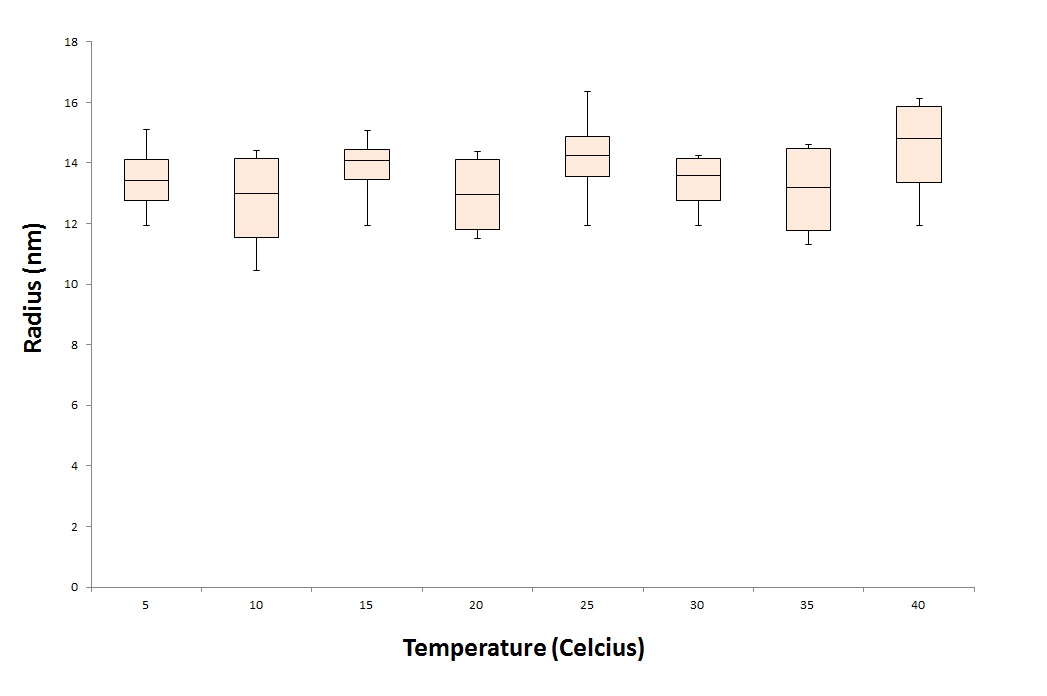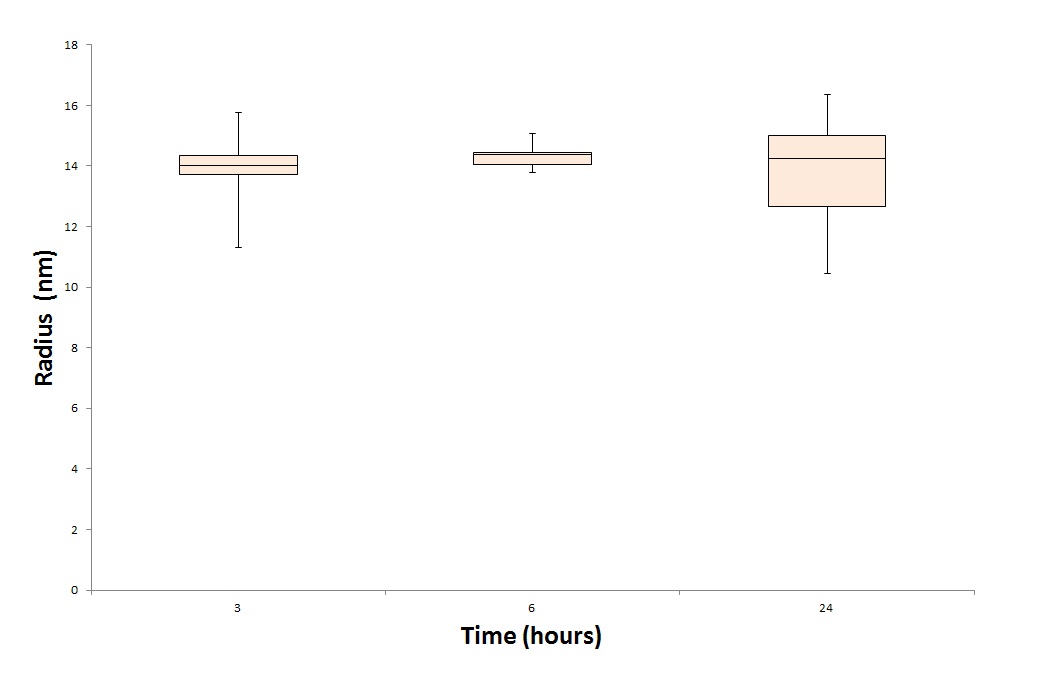Difference between revisions of "Part:BBa K883001"
MarkvanVeen (Talk | contribs) (→Functional Parameters) |
MarkvanVeen (Talk | contribs) (→Functional Parameters) |
||
| Line 36: | Line 36: | ||
[[Image:T_depend.jpg|500px|center|thumb|''Figure 1'']] | [[Image:T_depend.jpg|500px|center|thumb|''Figure 1'']] | ||
| + | CCMV VLPs are renown for its wide pH stability. It is stable between a pH range of 4.7 and 6.5. At a pH of 4.7 the CCMV is in it's unswollen form with a radius of around 14 nm. At a pH of 6.5 it is in it's swollen form, the VLPs radius is around 15-16nm. It is possible to change form, but change the pH gradually with the use of dialysis. If you change the pH too sudden, the VLPs are falling apart and forms aggregates. | ||
| + | |||
| + | Under perfect conditions (pH at 4.7, T = 4 degrees Celcius) it is possbile to store the CCMV coat protein with the first 25 amino acids replaced with a Histidine tag (6x) for a good few weeks. Be aware that aggregate formation may occure when the VLPs are exposed to changing pH or temperature. | ||
| − | |||
[[Image:Time_depend.jpg|500px|center|thumb|''Figure 1'']] | [[Image:Time_depend.jpg|500px|center|thumb|''Figure 1'']] | ||
Revision as of 12:48, 25 September 2012
CCMV wt coat protein under IPTG induced promoter
CCMV is an abriviation of the Cowpea Chlorotic Mottle Virus, one of the most studied viruses in producing Virus Like Particles (VLPs). This part is the coding sequence of the coat protein of the CCMV virus. When expressed in Escherichia coli, these coat proteins can be harvested and be assembled in vitro using the Wageningen_UR iGEM 2012 protocols. This part is provided for the iGEM community so that they can use this part to produce these VLPs for their one own use, including but not limited to packaging, making fusion proteins to the N/C terminal. This all for to be used in a wide variety of applications. for ideas what kind of applications can be mediated with CCMV VLPs, check http://2012.igem.org/Team:Wageningen_UR/Applications
Usage and Biology
Protocols for production and purification:
- [http://2012.igem.org/Team:Wageningen_UR/Protocol/StartupCCMV| CCMV production protocol part 1]
- [http://2012.igem.org/Team:Wageningen_UR/Protocol/DialysisCCMV| CCMV production protocol part 2]
- [http://2012.igem.org/Team:Wageningen_UR/Protocol/RoundupCCMV| CCMV purification protocol]
Results
PICTURE EM PICTURE DLS DETECTION
Background
This part is made from the wild type CCMV coat protein. CCMV is the abbreviation of Cowpea Chlorotic Mottle Virus, and is a well studied black eyed pea infecting virus. It is a virus in the family Bromoviridae, and it is one of the most studied plant viruses. As from the discovery of the virus in 1967, it was an interesting virus due to the easy cultivation and harvesting procedures involved. Interest in this virus is especially in the ability to disassemble the virus, remove the content and refold the empty particle simply by altering the pH. This makes this virus one of the first and best studied Virus Like Particles.
Sequence and Features
- 10COMPATIBLE WITH RFC[10]
- 12COMPATIBLE WITH RFC[12]
- 21COMPATIBLE WITH RFC[21]
- 23COMPATIBLE WITH RFC[23]
- 25INCOMPATIBLE WITH RFC[25]Illegal AgeI site found at 368
- 1000COMPATIBLE WITH RFC[1000]
Functional Parameters
T stability
CCMV VLPs are renown for its wide pH stability. It is stable between a pH range of 4.7 and 6.5. At a pH of 4.7 the CCMV is in it's unswollen form with a radius of around 14 nm. At a pH of 6.5 it is in it's swollen form, the VLPs radius is around 15-16nm. It is possible to change form, but change the pH gradually with the use of dialysis. If you change the pH too sudden, the VLPs are falling apart and forms aggregates.
Under perfect conditions (pH at 4.7, T = 4 degrees Celcius) it is possbile to store the CCMV coat protein with the first 25 amino acids replaced with a Histidine tag (6x) for a good few weeks. Be aware that aggregate formation may occure when the VLPs are exposed to changing pH or temperature.
*Safety notice*
This part is isolated from a virus and, when assembled, will form particles that very much resemble this virus in size and shape. However, no additional viral information is stored in this part and viral infection and/or replication can therefore be ruled out. It is completely safe for use in normal laboratory circumstances.


